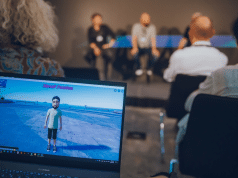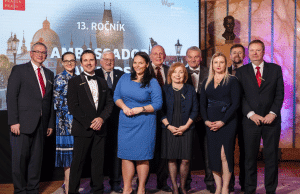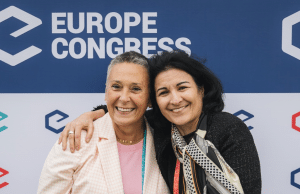Writer: Gorazd Čad
[pullquote]It is probably no coincidence that the director of the world’s leading congress destination, Christian Mutschlechner of Vienna, was the first to answer our questions, in fact within just a few hours of us sending out the invitation.[/pullquote]In May this magazine’s editorial board carried out an experiment: we sent out a request for a short interview (Quick Talk) to 42 key persons of convention bureaus and in the invitation we specifically pointed out that for the needs of our experiment we would assess the accessibility and responsiveness of each of the convention bureaus. Most of these convention bureaus work in the public interest and the purpose of our experiment was to create a publication of in-depth content for which the mission was to provide information about congress communities. Given the complexity of answers we needed, the deadline was a full seven days.
Within the allocated response time we received 18 responses, or 42.68% of the total, which together with responses coming late but sent in a timely way (4 in total) came to 52.38%. All of the invited partners from Austria, Slovakia, the Czech Republic and Slovenia answered the questionnaire on time, as did colleagues from Istanbul, Athens and one convention bureau from Croatia. From the results it would then appear that the Central European EU border is at the same time a border regarding the culture of communication with the media.
Indeed all of the region’s leading positions on the ICCA scale were the first to answer our questions. None of this is a coincidence, and they have an equally well-developed culture of communication with potential clients.
The broader Southeastern Europe (SEE) region, however, is one in transition, a transition that is also reflected in this realm of public information. In SEE it is clearly inadequate and as a consequence the individual is unable to develop a clear image of the functioning of specific convention bureaus or conference destinations. Meeting planners most likely confront a similar problem when deciding on whether to organise a congress in this part of Europe.
Personal contact is crucial
It is therefore very interesting when we look more closely at each destination’s response to the question “How hard is to get the message out about everything that your destination has to offer?”
Respondees believe that the more the destination is developed, the more effort must be invested in consolidating its image and what sets it apart from the competition. An important role is here played precisely by their media relations, in the form of press trips and partnerships in key industry events.
Moreover, a generally held opinion is that the most profitable route is that of building long-term individual relationships with potential partners interested in the destination, but a shortcoming with this is when we don’t know who our customers are or what their needs are. When this foundation is laid, it can be followed up by targeted communication through relevant storytelling and whilst this may sound easy in the era of total digitalization, it is an entirely different challenge to find good and worthwhile stories. For this the cooperation between convention bureaus and their partners is key. One of the best examples of this is the content network the Slovenian Convention Bureau has built in recent years – only a few bureaus have developed a good CRM system associated with marketing automation tools for this kind of communication.
Of the other various responses received one that it is worthwhile pointing out is the answer that the best thing a destination can do is to bring the client to the destination and convince them ‘live’ of their advantages, so they can become familiar with the stories that they have previously communicated to them.
New destinations have the prevailing opinion that the fact that they are undiscovered destinations is an important factor regarding the general public interest. They mostly rely on their own channels, including the most popular social media and digital marketing, and most of them believe in the personalization of customer relations, but they believe that it is a long-term process. In these cases there are very few innovations in the field of relationships with existing congress participants, who are the best ambassadors of convention destinations. Only a few congress bureaus really work in this area and better communication innovation is lacking here. The story of Athens, which has had to face waves of negative publicity during the European economic crisis, is an interesting one. As a destination and precisely during this period they made the highest investment in intensive communication with their customers, with a big role in this also played by the positive experiences of individual organisers and participants.
A resounding ‘Yes’ for content marketing
The meeting industry is an industry of storytellers. It’s therefore one where content marketing fits in very well. ‘Without content there are no congress participants’. It’s hard to disagree with this statement and we were pleased that 98% of those interviewed said that content marketing today is the foundation of marketing congress destinations.
It is important to emphasize, however, that the absolute foundation is a quality infrastructure and a renowned level of service, something the Vienna Convention Bureau’s Christian Mutschlechner was particularly keen to emphasize. It is only upon this kind of platform that quality content marketing can begin to be built and only honest, real stories that do not promise experiences that the destination cannot deliver will help bring success to a destination. Content marketing therefore has to be coordinated with the promise of the destination as a brand. The keywords for this are clear, relevant, authentic, useful and, finally, inspiring. The generic, easy-destination content of yesteryear no longer works today and more often than not ends up as spam and respondees were also keen to highlight that content marketing is much more than the basic SEO prevalent in digital marketing today.
The connection between experience marketing and content marketing is also interesting and was highlighted by a number of those who responded. Good content is the basis of the live experience, which congress organisers have been leaning on since time immemorial. The biggest innovation in this field is, of course, in the organisation of fam trips.
In this context Istanbul CVB uses video statements of congress organisers, which has proved to be a very effective method of promotion. Through this organisers become promoters of the destination and the response to Istanbul CVB’s campaign was very positive.
Today only a small proportion of stories attract our attention, as more and more we focus our attention on what is useful to us or entertains us. Through content marketing, however, we offer our buyers the kind of stories that are relevant to them and as a result they reward us with their loyalty and business. If we do not bother to tell such stories by ourselves, it is highly likely that clients will create their own stories, which may sometimes even be negative ones. But when positive and effective stories connect with effective sales, the path to success is wide open.
Communication starts with basic information exchange and it is always a two-way process. Content marketing, namely the deliberate creation and distribution of relevant content for the purpose of enthusing organisers, is one of the great tools of communication.

From our own practice we offer below some tips, experiences and also some of our concerns:
- Customer data management
The success of content marketing is primarily driven by pinpointing the right target groups. Only then can it be followed up by creating the right stories and nurturing creativity in communication methods. Often, a meetings destination devotes much attention to branding and external appearance rather than finding the audience that matches their product and story. If we successfully select the target group we can significantly and quickly acquire new customers, and in doing it this way quality definitely rises above quantity – the properly identified buyers will be drawn to the well-developed content.
To reflect on: Do you use modern CRM tools to manage a database of potential congress customers?
- Understanding the needs of meeting planners
Meeting organisers are overwhelmed with stories these days. For meeting planners the important stories are the ones that address their concerns. According to our analysis of news published on the IMEX system, only 25% of stories are relevant to meeting planners (‘MICE newsworthy’), meaning there is significant room for improvement in in this area. We need to think firstly of for whom, or to whom, we are writing and understand that our content is there to help solve others’ problems. The most widely read stories are therefore best practice, practical tips for organising events, background stories about providers, presentations of the key event planners, ideas for event organisatio and other such useful topics.
To reflect on: Are you measuring which content is most read on your website, and consequently which most interests meeting planners?
- Inventory of stories
The key to successful communication is not in the extent of content generated or frequency of publication, but in the context of what is interesting for meeting organisers. A lot of effort must therefore be invested in finding the right stories that are in line with the business thinking of your customers and potential customers. The key to success is in knowing at any given moment the kind of content you have to provide to your customers on each occasion. Congress stories can in this way be seen as a kind of ‘seed capital’ for successful convention destinations.
To reflect on: In your communication do you have content prepared for different target groups, from associations through to corporative clients?
- The intelligent distribution
If you know your target audience and know what can help guide a user to making a particular positive business decision, the decision on the method of distribution is easy – you need to communicate at the key points where customers collect information. A powerful anchor web (web portal) therefore plays a big role in this, as it is the basic medium of communication and also enables smart analytics. Alongside that several destinations have also built a community on one of the social networks, but direct marketing is still very much alive with all the tools that are available today.
To reflect on: Are you planning weekly publications on social media such as Facebook, Twitter, LinkedIn, YouTube or Slideshare and do you have a weekly plan for this?
- Personalisation and Automation
Marketing information systems and analyzing web traces is the basis for quality communication personalisation. A marketing system allows monitoring of potential customers through every phase of the purchase process. Such a system also allows the personalisation of digital experiences and connection with the CRM system, which leads to personal sales. According to our observations, meetings destinations that are already using content marketing invest very little investment, or none at all, in measuring the effects of this and adapting the project ends. This is crucial, and not just any measurement, but those relevant for long-term business success.
To reflect on: Does your destination use the appropriate CRM tools and marketing information system?
- Social media are story boosters
Today social media and content marketing are a winning combination. With social networks you can create awareness about your brand and at the same time you can direct customers to additional content on your website. With their viral potential social networks are also evidence that your congress service is trustworthy, which can be done by using the various tools of content marketing, from the publication of informative articles and webinars to demos, videos, case studies of good practice and white papers.
To reflect on: Have you set key performance indicators (KPIs) for the social networks and do you know how to measure social media analytics tools?
- Events are a part of content marketing
Event management is not just the implementation of the programme and all the supporting logistics, but it is the story and everything else that goes with it, from exciting the client and participants about the destination to the positive experiences that happen at the event, including how best to communicate with participants. It is the quality of relations with stakeholders that we create through content marketing that is a crucial aspect of the success of the event. Events are key tools for preserving, nurturing and upgrading relations with stakeholders and their efficacy is made in synergy with other content marketing tools.
To reflect on: Think about events that you remember most and why.
- Excellent texts, attractive design
Content marketing is often equated to preparing texts, which is very far from the truth. Professionals in the realm of content distribution (photographers, graphic designers, video producers, journalists) are certainly all key to the success of content distribution, but communication is a skill that is becoming increasingly important and today it is not possible to think of convention destination representatives without also thinking of public speaking and communication skills.
To reflect on: Are you thinking about employing a content marketing manager, social media manager…?
- Create your own media
In the digital age the creation of your own media is easy, logical and certainly cheaper than in the analog age. It can be as easy as a LinkedIn profile with the relevant target group, a corporate magazine or just a blog. Good content is the communication capital of your company. Just think of incentive programmes that you have developed and maybe even protected by copyright – this is a kind of seed capital that can yield great results. Of course, such capital is totally valueless if you do not take care of properly distributing the content, and preferably through your own media.
To reflect on: Which media you have developed at your destination: a web page, corporate magazine, blog, social network LinkedIn, Facebook, Twitter…?
- Destination editorial
Planning, preparing and effectively curating content is a key part of a convention and destination organisation’s activities. With social media the importance of relevant, timely and appropriate content is even bigger. Destination organisations have to teach their partners how to recognize a good story and how to use the various modes of digital and social content, and are thereby becoming more and more a destination guide editorial board. Destination organisations also have the task of verifying which posts are suitable for publication and which are not. It is therefore surprising that 65% of online portals are offering outdated and irrelevant news.
To reflect on: How many useful stories did you post on your website last month and how do you measure their readership?
PS: The right to information is at the heart of democracy!
The majority of constitutions of European countries give everyone the right to obtain information of public interest, which is one of the fundamental human rights. In addition, public institutions have to provide the public with their work by providing timely, complete and accurate information on issues within their working areas.














